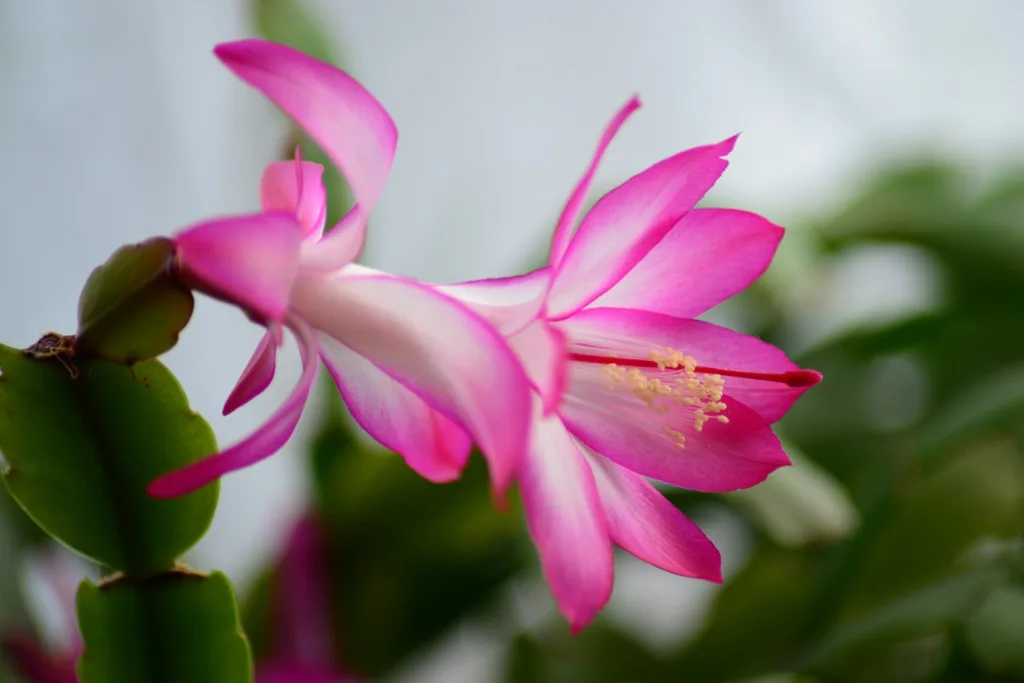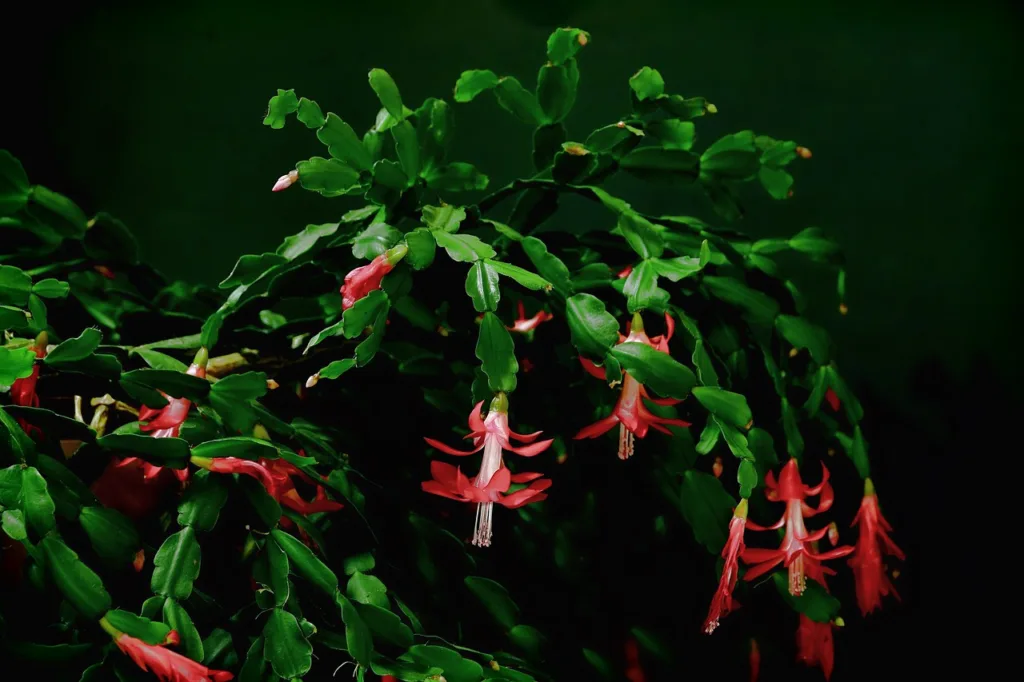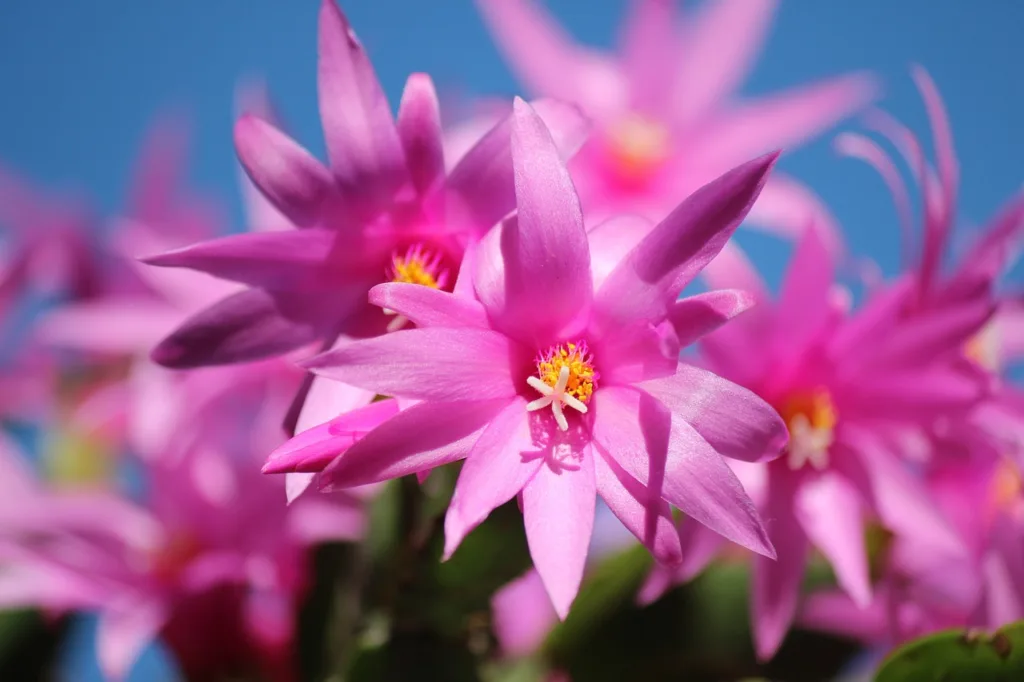Christmas cactus, also known as Schlumbergera, are popular houseplants that can bring a touch of holiday cheer into our homes.
With their vibrant flowers and unique leaf structure, these cacti have gained a reputation for being relatively easy to care for.
Native to the cloud forests of Brazil, this cactus has distinctive flattened, segmented stems with scalloped edges. Despite its name, it is not a true cactus but rather a tropical epiphyte.
In this article, we’ll into the secrets of successfully growing and nurturing a Christmas cactus, ensuring that it thrives and blooms year after year.
| Feature | Description |
|---|---|
| Scientific Name | Schlumbergera spp. (several species and hybrids) |
| Common Names | Christmas Cactus, Holiday Cactus |
| Origin | The coastal mountains of Brazil |
| Type | Succulent cactus plant |
| Appearance | Segmented flat stems with scalloped edges |
| Flowers | Bright, tubular flowers in various colors (red, pink, white) |
| Bloom Time | Typically in late fall to winter (around Christmas time) |
| Growing Environment | Bright, indirect light; well-draining soil; moderate humidity |
| Temperature Range | Cool to warm temperatures; avoid extreme heat or cold |
| Watering | Allow soil to dry slightly between waterings; avoid overwatering |
| Fertilization | Feed with a balanced, water-soluble fertilizer during the growing season |
| Pruning | Remove spent blooms and shape if necessary |
| Common Varieties | Schlumbergera truncata, Schlumbergera russelliana, various hybrids |
| Propagation | Stem cuttings or segments can be rooted in soil or water |
| Uses | Popular as a festive indoor plant during the holiday season |
| Care Level | Moderate; requires attention to light, water, and temperature conditions |
| Special Features | Epiphytic nature; blooms in response to shorter daylight hours |
| Potential Issues | Susceptible to root rot if overwatered; prone to bud drop in stressful conditions |
| Toxicity | Generally non-toxic to humans and pets |
Choosing the Right Christmas Cactus
The first step in growing a healthy Christmas cactus begins with selecting the right plant. When you visit your local nursery or garden center, keep the following tips in mind:
- Look for a plant with healthy, vibrant-looking leaves. Avoid any plants with discolored or wilted foliage.
- Check the roots to ensure they are not encircling the pot. If the roots have outgrown the pot, the plant might have trouble thriving.
- Examine the plant for signs of pests such as aphids or mealybugs. These pests can damage the plant and spread to your other houseplants if not addressed promptly.
Once you’ve chosen your cactus, it’s time to get it settled in its new home.

Optimal Growing Conditions of Christmas Cactus
Lighting: Christmas cactus prefers bright, indirect light. They can tolerate some direct sunlight, especially during the winter months, but too much direct sun can scorch their leaves.
Place your plant in a north or east-facing window, or a few feet away from a south or west-facing window, to provide it with the desired lighting conditions.
Temperature: These cactus thrive in temperatures between 60 to 70°F (15 to 21°C). Avoid exposing them to extreme cold or hot drafts, as it can cause stress and affect their blooming.
Humidity: Christmas cactus are native to the humid forests of Brazil. To mimic their natural environment, it’s beneficial to create a more humid setting for your indoor plant. You can achieve this by placing a tray with water near the plant or using a humidifier.
Soil and Potting: A well-draining soil mix is essential for the health of your Christmas cactus. Use a combination of potting soil, perlite, and orchid bark to create a loose and fast-draining blend. Choose a pot with drainage holes to prevent waterlogged roots.
Watering and Feeding of Christmas Cactus
Watering: The Christmas cactus has unique watering needs. It prefers to be on the slightly drier side, but not completely dry.
Over-watering can lead to root rot, while underwatering can cause the plant to wither. A good rule of thumb is to water your cactus thoroughly whenever the top inch of the soil feels dry to the touch. Allow any excess water to drain from the pot, ensuring it’s not sitting in standing water.
Fertilize: Fertilizing your Christmas cactus can give it an extra boost to promote growth and abundant blooms.
During the active growing season, from spring through early fall, feed your plant with a well-balanced, diluted houseplant fertilizer every two weeks. Reduce the frequency during the fall and winter months, as the plant enters its dormant phase.

Encouraging Blooms Christmas Cactus
The most enchanting feature of the Christmas cactus is its stunning display of flowers. While these plants are naturally inclined to bloom during the holiday season, proper care and environmental conditions can encourage more prolific blooming. Follow these tips to increase your chances of a show-stopping display:
Temperature Induction: To trigger blooming, your Christmas cactus needs a period of darkness. Starting around mid-October, ensure your plant receives 12-14 hours of uninterrupted darkness each night.
This can be achieved by covering it with a cardboard box or placing it in a dark closet. During the day, place it in a well-lit location as usual. Continue this routine for about six weeks, and you should see buds forming.
Temperature Fluctuations: Mimicking the temperature variations of its natural habitat can also stimulate blooming. Keep your plant in an area with a slightly cooler temperature, around 50-55°F (10-13°C), for a few weeks leading up to the blooming period.
Troubleshooting Common Issues
Even with the best care, problems can occasionally arise. Here are some common issues you may encounter with your Christmas cactus and how to address them:
Yellowing Leaves: Yellowing leaves often indicate a problem with watering. If the leaves turn yellow and feel mushy, your plant may be receiving too much water. On the other hand, if the leaves turn yellow and feel shriveled, they may not be receiving enough water. Adjust your watering routine accordingly.
Wilting or Drooping: Wilting or drooping can be a sign of underwatering or underwatering. Check the moisture level of the soil and adjust your watering accordingly. Additionally, ensure your plant is not exposed to extreme temperatures or drafts.
Lack of Blooms: If your Christmas cactus fails to bloom, it may be due to insufficient darkness during its resting period or inadequate temperature fluctuations. Review your plant’s light exposure and temperature conditions and make the necessary adjustments.
Types of Christmas Cactus
There are several types of Christmas Cactus, and they are primarily differentiated by their species and hybrids. Here are some common types:
- Schlumbergera truncata: This is the traditional Christmas Cactus with scalloped stem segments and vibrant tubular flowers. It’s one of the most popular varieties.
- Schlumbergera russelliana: Similar to Schlumbergera truncata, this variety also features flattened stem segments and produces colorful blooms around the Christmas season.
- Schlumbergera x buckleyi: This is a hybrid Christmas Cactus resulting from the crossbreeding of different Schlumbergera species. It often displays a combination of characteristics from its parent plants.
- Schlumbergera opuntioides: This variety is known for its long, arching stems and slightly different growth habits compared to the more common types.
- Schlumbergera orssichiana: This species has distinct stem segments with more pronounced scallops and typically blooms in shades of pink and purple.
- Hybrid Varieties: There are numerous hybrid Christmas Cactus varieties available in various colors, including red, pink, white, and even multicolored blooms. These hybrids are often bred for specific characteristics such as flower size and color intensity.

Conclusion
Successfully growing and caring for a Christmas cactus requires a bit of patience and attention to detail. By providing optimal growing conditions, such as the right lighting, temperature, and humidity, as well as following the proper watering and feeding routine, you can ensure your cactus thrives.
To encourage abundant blooms, remember to induce dormancy and provide temperature fluctuations. With these tips in mind, you’ll soon enjoy the incredible beauty of your Christmas cactus, becoming a festive focal point in your home for many holiday seasons to come.
People also ask
Does Christmas cactus like sun or shade?
Sunlight Preferences: Christmas cacti prefer bright, indirect light but can tolerate some direct sunlight. However, prolonged exposure to intense sunlight should be avoided. Partial shade or filtered sunlight is ideal.
Is Christmas cactus good for home?
Suitability for Home: Christmas cacti make excellent houseplants. They are relatively easy to care for and can thrive indoors, bringing festive blooms during the holiday season. They are non-toxic to pets, making them a safe choice for homes with animals.
What is special about Christmas cactus?
Special Characteristics: One unique feature of Christmas cacti is their ability to bloom in response to changes in light and temperature.
They typically flower in late fall to winter, adding a splash of color during the holiday season. Additionally, their segmented, flat stems give them a distinctive appearance.
What is the lifespan of a Christmas cactus?
Lifespan: With proper care, Christmas cacti can live for many years, and some may even become family heirlooms, passed down from generation to generation.
Adequate watering, suitable light conditions, and occasional fertilization contribute to their longevity.
why are the leaves on my christmas cactus limp?
Limp Leaves: Limp or drooping leaves on a Christmas cactus may be a sign of overwatering, underwatering, or stress due to environmental factors.
Ensure that the plant is watered appropriately, allowing the top inch of soil to dry between waterings. Providing the right balance of light and maintaining a consistent environment can help prevent leaf issues.

